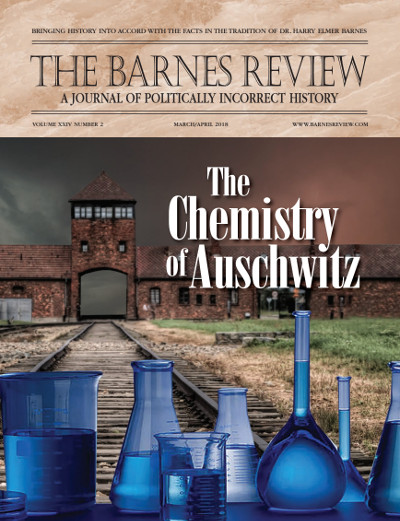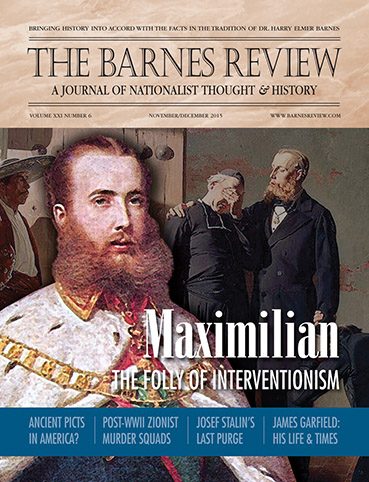Description
MARCH/APRIL 2018 VOLUME XXIV NUMBER 2
TABLE OF CONTENTS
THE CHEMISTRY OF AUSCHWITZ BY JOHN WEAR, J.D.
Were the facilities the Germans possessed in the 1940s practical—even suitable—for killing mass numbers of prisoners as described in mainstream history books? What remnants of the poisonous chemicals have been found in the chambers? What do Revisionists claim about the chemistry of Auschwitz-Birkenau concentration camp?
JEWISH SURVIVORS SPEAK FROM AUSCHWITZ-BIRKENAU BY JOHN WEAR, J.D.
The Court Historians assert that Germany’s WWII concentration camps were centers of mass slaughter, whereas Holocaust Revisionists say too many “useless eaters” were kept alive at great expense to justify that claim. Who did survive, and what did they say about their experiences?
HÖSS CONFESSES TO EVERYTHING BY SANTIAGO ALVAREZ
If one has any doubts the Germans slaughtered millions of innocent people during WWII in poison gas chambers, or that the camps were no more than extermination centers, one need only look at the confessions of Auschwitz Commandant Rudolf Höss. He confessed to everything and more. But are his confessions truthful?
WHY THE ALLIES WEAPONIZED THE HOLOCAUST NARRATIVE BY JOHN WEAR, J.D.
As with any war, the victors write the history books with a keen eye toward whitewashing their own crimes and exaggerating the crimes of others. This was especially true after World War II due to the sheer volume of war crimes committed by the victors themselves.
THE MALMEDY WAR CRIMES TRIAL: WHY THE VERDICT WAS RIGHT BY JOHN WEAR, J.D.
Recently a would-be Revisionist scholar attempted to rewrite history and prove the verdicts in the Malmedy War Crimes Trial were too lenient. Here’s why he fell flat on his face.
THE ARTIST WITHIN THE WARLORD BY PROFESSOR RAY GOODWIN
This longtime Texas-based teacher, scholar and author tells us why TBR’s new book, The Artist Within the Warlord: An Adolf Hitler You’ve Never Known, by Carolyn Yeager and Wilhelm Kriessmann, is must reading. Even Ray saw a few things he’d never seen in any other book.
THE NUREMBERG STRANGLER BY CAROLYN YEAGER
After World War II ended, the Allies, bent on bringing vengeance down on the military and ideological leaders of a defeated enemy, convened a series of sham legal proceedings with predetermined outcomes. In the end, 11 men were doomed to hang. Luckily for the Allies, they had the perfect psychopath to carry out the deed.
SAGA OF THE PARATROOPER GENERAL BY RONALD L. RAY
Though you may have never heard his name before, Hermann-Bernhard Ramcke was an eyewitness to, and a participant in, some of the most momentous events of WWII. After the war, he was accused of war crimes committed in Brest, incarcerated, escaped, returned voluntarily, was convicted and finally released. Here is Ramcke’s WWII saga—taken from his own words.
THE TRIAL OF HERMANN RAMCKE BY V.J.P. VEALE
V.J.P. Veale is best known for his two-book set Advance to Barbarism, written in the 1950s. In it he dedicated an entire section to the war crimes trial of Hermann-Bernhard Ramcke. Read what Veale thought about the proceedings.
GERMANY’S CONSTITUTION A FLOP BY STEPHEN MITFORD GOODSON
A constitution for the Germans would be nice, thought the Allies in 1949. The Soviets were now the largest threat to the West, and a transition from military occupation to self-governance was needed in Germany. But few know about the secret agreement arranged the night before the constitution was signed—May 23, 1949—sealing Germany’s fate until 2099.
The Chemistry of Auschwitz
Could Hitler’s gas chambers really have killed 6 million people, as the mainstream insists? Here is a scientific analysis of that question.
By John Wear
Defenders of the Holocaust story have attempted to discredit scientific reports that disprove the existence of homicidal gas chambers at German labor camps during World War II. For example, Deborah Lipstadt’s defense attorney, Richard Rampton, referred in court to The Leuchter Report as “a piece of so-called research which is not worth the paper it is written on.”1
Dr. Richard Green states about Germar Rudolf: “Owing to the fact that he actually has some understanding of chemistry, many of his deceptions are more sophisticated than other Holocaust deniers. . . . Ultimately, he engages in the same deceptions and specious arguments as [Fred] Leuchter and [Walter] Lüftl, but the case he makes for those deceptions and arguments involves more difficult chemistry.”2
This article will discuss attempts by chemists to discredit scientific reports that disprove the existence of homicidal gas chambers at Auschwitz/ Birkenau during World War II.
HISTORICAL BACKGROUND
In 1988, the Canadian government put Ernst Zündel on trial a second time for the criminal offense of knowingly disseminating false news about “the Holocaust.” As part of his defense in this trial, Zündel commissioned the American gas-chamber expert Fred Leuchter to make a scientific examination of the alleged homicidal gas chambers at Ausch – witz, Birkenau and Majdanek. The resulting Leuchter Report is the first scientific study of the alleged German homicidal gas chambers.3
In addition to reporting that the alleged homicidal gas chambers at Auschwitz, Birkenau and Majdanek were structurally unsuitable for gassing, Leuchter researched the chemical properties of the Zyklon B fumigant. Leuchter found that Zyklon B is a highly toxic compound that releases deadly hydrogen cya – nide gas.
The released hydrogen cyanide gas clings to surfaces and reacts chemically with materials containing iron, forming ferrocyanide compounds that have a distinctive blue color called Prussian blue. Since building materials normally contain a certain amount of rust (iron oxide, usually between one and four percent), repeated exposure to hydrogen cyanide gas would result in Prussian blue staining on the walls of the alleged gas chambers.4
Leuchter took forensic samples from the alleged gas chambers at the visited sites and a control sample from the delousing facility at Birkenau. The samples were analyzed by an independent laboratory in the United States. The laboratory found no significant ferrocyanide compound traces in the samples taken from the alleged homicidal gas chambers, but the sample from a wall of the Birkenau delousing facility had heavy concentrations of the ferrocyanide compounds. Leuch ter concluded that this result would be impossible if the alleged homicidal gas chambers had been repeatedly exposed to hydrogen cyanide gas.5
Germar Rudolf, a certified chemist, expanded on Leuchter’s work by writing the Rudolf Report in the spring of 1992. The Rudolf Report, which has been updated and revised several times, focused on engineering and chemical aspects of the alleged homicidal gas chambers at Auschwitz and Birkenau. Rudolf observed in his on-site examinations that all of the delousing facilities at Auschwitz, Birkenau, Stutthof and Majdanek have one thing in common: their walls are permeated with Prussian blue. Not only the inner surfaces, but also the outside walls and the mortar between the bricks of the delousing facilities have Prussian blue staining. Nothing of this sort can be observed in any of the alleged homicidal gas chambers at Auschwitz and Birkenau. Rudolf also took samples from the alleged homicidal gas chambers and the delousing facilities at Auschwitz and Birkenau.
Similar to Leuchter’s samples, the alleged homicidal gas chambers exhibit only insignificant traces of ferrocyanide residue on the same order of magnitude found in any other building. The samples from the delousing chambers, however, all showed very high ferrocyanide residues. Rudolf determined that, if mass execution gas – sings with hydrocyanic acid had taken place in the alleged homicidal gas chambers, the rooms in the alleged homicidal gas chambers would exhibit similar ferrocyanide residue as the delousing chambers. Therefore, Rudolf concluded that mass gassings with Zyklon B did not occur in the alleged homicidal gas chambers at Auschwitz and Birkenau.6


